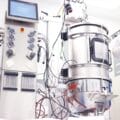~ Overcoming staffing, supply chains and standard IC challenges ~
The UK’s electronics sector grew by 4.9 per cent in 2023, growth approximately five times as strong as the sector average according to a report by Make UK. Despite the strong performance, the report also expects UK output to drop this year. Here, Ross Turnbull, Director of Business Development and Product Engineering at ASIC design company Swindon Silicon Systems, explores why, and what can be done to improve the industry’s trajectory.
Electronics demand remains strong in Europe. This is largely thanks to continued digitalisation efforts, such as the adoption of automation technologies. But despite healthy growth projections for the industry and a seemingly infinite number of possible applications for electronics devices, it isn’t all smooth sailing. The electronics sector faces a number of unique issues.
Shortfalls in recruitment
The skills gap is one example. The most recent Manufacturing Outlook report published by Make UK states that the electronics sector has seen a consistently increased demand for workers since the Covid-19 pandemic with an estimated 68,000 live vacancies available at the beginning of 2024. Meanwhile, McKinsey predicts a shortfall of more than 100,000 semiconductor engineers in Europe alone by 2030.
The demand for certain types of skill is also seeing a shift in the industry. From a semiconductor perspective, AI and machine learning knowledge is beginning to overtake demand for system architecture knowledge.
Reassuringly, efforts are being made to close the talent gap. Make UK’s report also finds that manufacturers plan to invest in both human and physical capital in 2024, with a 30 per cent balance of change in employee investment. Results from the 2024 Skills Horizon Barometer report, produced closely with the government’s Skills for Life campaign, offer a similarly positive outlook: three in five manufacturing SMEs are now looking to offer enhanced training schemes for existing employees, plugging foreseeable skills gap while boosting retention.
Supply chain concerns
Issues with the supply chain have been well documented over the past few years. In a study into the electronics industry conducted by Maersk, 100 per cent of respondents stated that they had faced delays in sourcing components or finished goods.
Component obsolescence is a big factor in supply chain security. In fact, research by Z2Data found some 473,910 parts became obsolete in 2023. Though this is a drop from previous years — with 528,546 parts becoming obsolete in 2021 and a staggering 756,087 in 2022 — it’s clear that obsolescence continues to be problematic.
But minimising obsolescence risks is easier said than done. The accelerating rate of technological progress means that as chips become more and more advanced, demand for older designs drops off. Manufacturers therefore need to take a more proactive approach. Identifying obsolescence risks early is one of the best ways to enhance supply chain security and minimise any problems on the production line.

Standard ICs
As semiconductor use has grown, so too has the complexity of its applications. We can now find a number of ICs in just about anything, ranging from smart home devices and mobile phones to vehicles and industrial robots.
However, manufacturing IC devices to meet the demands of these increasingly demanding applications proves to be a challenge. Commonly, freely programmable IC solutions such as field-programmable gate arrays (FPGAs) are used. Since FPGAs can be reconfigured post-manufacture, it’s possible to customise these standard ICs to the needs of your application. And for simple applications, FPGA reprogramming may be sufficient.
But for advanced and more sophisticated processes, FPGA performance may be lacking. With no choice of hardware within, there’s a limit to how much the performance of an FPGA can be optimised.

A custom solution
Instead of relying on off-the-shelf IC solutions, industry should make use of custom devices when required. These come in the form of an Application Specific IC, or ASIC. As entirely bespoke devices, an ASIC is a solution built to fit the application, rather than the customer needing to tweak their product to fit the IC.
As a result, the ASIC offers much higher performance than would be possible with a standard IC. Both power consumption and size reductions can be achieved through custom IC design. It also allows for a choice of communication protocols, memory and processor units for a solution fully tailored to specific application requirements.
And ASICs can also help to protect against the risk of obsolescence. Production of a standard IC can be halted at any time at the manufacturer’s discretion. But the approach with an ASIC is different. With an ASIC, the manufacturer will endeavour to ensure continuous IC supply. There are several different ways to achieve this, including the preservation of wafers in dry nitrogen cabinets as well as porting of the design onto a new silicon process. Choice of route is mutually determined between the manufacturer and customer for a solution that works for all parties.
Swindon Silicon has more than 40 years of experience supporting industrial and automotive applications with high performance ASIC solutions. As a company that has been at the forefront of direct tyre pressure monitoring system (TPMS) development since its inception, and now supporting half of all vehicles produced with TPMS, Swindon is a leader in its industry in terms of technological advancement.
The electronics industry continues to face significant challenges. But with these challenges come opportunities for innovation and growth. By addressing current concerns across the manufacturing process, the industry can continue to be at the forefront of modern development while securing the UK’s national and commercial security.








